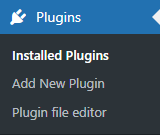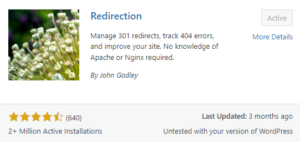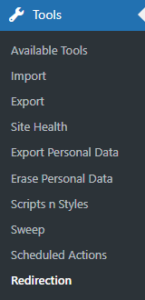- SEO
SEO Agency
Take advantage of the first traffic acquisition lever by entrusting your SEO to a digital agency experienced in SEO. - SEA
SEA Agency
Grow your business quickly with paid search (SEA).
- Social Ads
Social ads
Optimize your social media advertising campaigns to improve your performance.TikTok adsGo viral with your ads on TikTok

- Agency
The agency
Keyweo was born from the desire to create an agency that meets the principles of transparency, trust, experience and performance.
- Blog
- Contact
301 redirect
Home > SEO Agency > SEO Glossary > 301 Redirect
Definition
The 301 redirect, or code 301, is a permanent redirection from one URL to another. This means that when a user attempts to access an old URL, the server sends a 301 code indicating “Permanently Moved” to the search engine, thereby directing them to the new page.
With a 301 redirect, the popularity and SEO authority of the old URL are largely transferred to the new page. Therefore, 301 redirects are extremely useful for changing your site’s structure, URLs, or during a domain name change, to preserve the strength and ranking of your old pages (URLs).

301 redirect as a metaphor
To help you understand the concept of 301 redirect, let’s take a real-life example. Imagine a store that decides to move to a new location. The 301 redirect would act like a sign, left by the manager at the store’s old address. This sign would therefore inform customers that the store has moved, thus automatically guiding them to the new address. So, even when using the old address, customers are automatically guided to the new one, avoiding any confusion.

Differences between 301 and 302 redirect
In order to fully understand the concept of 301 redirect, it is also important to know about 302 redirect, as well as the differences between these two concepts. Even if the difference is only visible to Google robots and completely invisible to the user.
The 301 redirect , or code 301, is a permanent redirect , from one URL to another. This means that when a user tries to access an old URL, the server sends the search engine the 301-Permanently Moved code and redirects it to the new page, thus preserving the traffic and SEO power of the site. old URL. The 301 status code is a permanent redirect, which is used when a page is permanently moved.
The 302 redirection, or code 302, is used when you want to make a temporary redirection. The concept is the same as the 301 redirect, except that the 302 tells search engines that the requested resource (the page) is temporarily located on another URL, but that this redirect is only temporary and should change over time. This kind of redirection is often used when the webmaster or page manager makes changes to the original page and wants to redirect users to another page while waiting for the changes to complete.
The 302 redirect is frequently used in e-commerce for seasonal product pages, such as Halloween decorations or Christmas products. After the season, these pages are temporarily redirected, for example, to the homepage, because the products are no longer relevant or available. When the season returns, the redirection is removed, allowing the original page to reappear with its SEO intact. Using a 302 redirect in this specific context allows you to keep your site up-to-date for users, while preserving the SEO of seasonal pages for future seasons, and strategically and logically redirecting your traffic.
To illustrate the 302 redirect, let’s consider the example of a store that needs to renovate its space. The 302 redirect would be like a sign indicating the store’s temporary new location while renovations are being completed.

From an SEO perspective, unlike the 301, the 302 redirect does not pass as much SEO power to the new URL because search engines continue to treat the old URL as the original address.
301 Redirect : SEO Advantages
301 redirects, when used correctly, have big advantages in SEO. Among the key advantages of redirects, we can find:
- Transfer of authority and SEO power : When you apply a 301 and Google deems it relevant and not abusive, the popularity of the old page is reinjected onto the new one. This transfers the majority of authority, backlinks, SEO power, and historical ranking on the SERP to the new URL.
- Improve user experience : 301s help improve user experience on your page because they ensure users have access to the content they are looking for. This will indirectly affect your SEO, by improving engagement, and reducing bounce rate.
- Transfer of “Link Juice” : 301 redirects will allow you to transfer the link authority (Link Juice) from the old URL to the new one. That is to say, all backlinks pointing to the old page will now point to the new URL, thus preserving the SEO power of these links.
- Optimization of Website’s URL Structure : If you are redesigning your site for business or SEO reasons, 301 redirects ensure that all changes do not negatively impact your SEO performance.
When to use a 301 redirect?
Duplicate Content
It is possible that certain pages on your site are too similar to each other. This is what we call duplicate content in SEO . That is to say, pages on your site that have very similar content to each other. You have to be very careful about this kind of error, which can happen accidentally. Google is strict with pages that offer similar content to each other, because having two pages that are similar on the same site does not provide any added value to users.
To avoid possible sanctions from Google, which may consider your duplicate content as a Black Hat technique , we advise you to use a 301 redirect between page A and page B which have similar content. Prioritize redirection to the page that has the best SEO results (average position, impressions, clicks, etc.).
Collect backlinks
We have often noticed, when carrying out free pre-audits , certain sites which had backlinks pointing to 404 pages, which is a shame because a backlink pointing to a 404 is a lost opportunity to improve SEO and authority of your site. By using a 301 redirect on this page, you can redirect the backlink authority to an active page on your site, and thus benefit from its SEO power.
Agency SEO tools , like Ahrefs, can help you detect all backlinks that point to a 404 page on your site. If you cannot afford to use paid tools, you can use Google Search Console (free Google tool) to detect all your 404 pages and carry out redirections.
Change of domain name
If you decide to change your domain name, it is crucial that you set up 301 redirects on all of your site’s old URLs to the new URLs. This is called an SEO migration or site redesign. Performing these redirects will allow you to benefit from all the authority and power of your old site on your new site.
A poorly executed migration can have disastrous consequences for a site’s SEO. This is why it is often preferable to call on SEO migration experts , to ensure that the migration goes smoothly.
HTTP to HTTPS Migration
301 redirects play a crucial role when migrating a site from HTTP to HTTPS . If your site still operates under the HTTP protocol, it is strongly recommended to switch to the HTTPS protocol, which represents a secure version. Migrating to HTTPS is essential for several reasons :
- Security : It protects the integrity and confidentiality of data exchanged between the user, the site and the browser.
- SEO : Google confirmed in 2014 that it favors sites using the HTTPS protocol, thus improving their rankings on the SERP.
- Trust : From a user perspective, an HTTPS site indicates that the site is secure, and therefore can improve user trust in your site.
To successfully migrate your site from one version to another, it is necessary to use 301 redirects. These are used to permanently redirect users and search engines from your old URLs to your new secure URLs in HTTPS.
Consequences of a modification without a 301 redirect
Changing URLs without implementing proper redirects can lead to a range of negative consequences that directly affect user experience, your traffic, conversions, search engine ranking, and more. The consequences for your site include :
404 Errors : If you don’t set up a 301 redirect for your obsolete pages/links, your users will end up on a 404 page, affecting their browsing experience and the reputation of your site.
Loss of Link Juice : All external links pointing to your site contribute to its domain authority. If you change your URL without redirecting, the SEO power of the external links that pointed to your old page will be lost.
Decrease in SERP Ranking : Even if your old URL was crawled, indexed, and ranked, without a redirect, this SEO value is lost, leading to a decrease in your Google ranking.
Loss of Traffic : If you don’t implement redirects on your obsolete pages, the traffic that would normally have been directed to the old URL will not be redirected to the new one, resulting in an inevitable loss of traffic.
Create a 301 redirect on different servers
Create a 301 redirect on Apache servers (.htaccess)
If your site is on an Apache server, you will need to modify your site’s .htaccess file to be able to carry out your redirections.
If you don’t remember the server your site is on, go to the Icann Lookup site . All you have to do is enter your domain name in the search bar to check your server.
To add your 301 redirects to the .htaccess file, follow the following examples, depending on your redirection needs.
The expression “ RedirectPermanent ” can also be used in the following form: “ Redirect 301 ”. The result is identical, so the choice is yours.
Single page redirection
RewriteEngine On
RewriteRule ^oldpage\.html$ /newpage.html [R=301,L]
or
RedirectPermanent /oldpage.html /newpage.html
Redirecting an entire domain
RewriteEngine On
RewriteCond %{HTTP_HOST} ^olddomain.com$ [OR]
RewriteCond %{HTTP_HOST} ^www.olddomain.com$
RewriteRule (.*)$ http://newdomain.com/$1 [R=301,L]
or
RedirectPermanent / http://newdomain.com/
Redirect with regular expression
RewriteEngine On
RewriteCond %{REQUEST_URI} ^/old-path/(.)$
RewriteRule ^old-path/(.)$ http://newdomain.com/new-path/%1 [R=301,L]
or
RedirectPermanent / http://newdomain.com/
Redirecting a directory
RewriteEngine On
RewriteRule ^old-directory/(.*)$ /new-directory/$1 [R=301,L]
or
RedirectPermanent /old-directory/ http://www.example.com/new-directory/
Redirecting a non-www URL to www
RewriteEngine On
RewriteCond %{HTTP_HOST} ^example\.com [NC]
RewriteRule ^(.*)$ http://www.example.com/$1 [R=301,L]
or
RedirectPermanent / http://www.example.com/
Redirection of a deleted page to specific pages
RewriteEngine On
RewriteRule ^deleted-page\.html$ /replacement-page.html [R=301,L]
or
RedirectPermanent /deleted-page.html /replacement-page.html
Global redirection of the entire site from HTTP to HTTPS
RewriteEngine On
RewriteCond %{HTTPS} off
RewriteRule ^(.*)$ https://%{HTTP_HOST}%{REQUEST_URI} [L,R=301]
or
RedirectPermanent / https://www.yoursite.com/
Create a 301 redirect on Nginx servers
Single page redirection
server {
listen 80;
server_name yoursite.com;
location /old-page.html {
rewrite ^/old-page\.html$ http://www.yoursite.com/newpage.html permanent;
}
# Other server configuration directives...
}
Redirecting an entire domain
server {
listen 80;
server_name yourdomain.com www.yourdomain.com;
return 301 https://www.newdomain.com$request_uri;
}
Global redirection of the entire site from HTTP to HTTPS
server {
listen 80;
server_name yourdomain.com www.yourdomain.com;
return 301 https://$host$request_uri;
}
Redirecting a non-www URL to www (and vice versa)
server {
listen 80;
server_name yourdomain.com;
return 301 $scheme://www.yourdomain.com$request_uri;
}
Create a 301 redirect, on different CMS
If you decide to do your 301 redirects directly from your CMS, the process will be much simpler. Indeed, a large part of the CMS available on the market facilitate the integration of redirections through the plugins and extensions present on these CMS.
We explain below how to set up your redirects on different CMS.
301 redirect on WordPress
Inserting a redirect in WordPress is quick and easy if you have the right plugin. That’s why we recommend installing the most well-known extension on WordPress for this type of task : Redirection.
To install the “Redirection” extension, click on the previous link or follow these steps:
- Go to your WordPress Dashboard.
- In the left-hand menu, click on “Plugins“>”Add New Plugin“.
- Search for “Redirection” in the top right search bar.
- Then click on “Install Now” on the “Redirection” extension.
Once the extension is installed on your WordPress account, you can start integrating your redirects. To do this:
- Go to your WordPress dashboard.
- In the lest-hand menu, click on “Tools“>”Redirection“.
- Once in the extension’s menu, click on “Add New“.
- Insérez l’URL que vous souhaitez rediriger dans la première barre de recherche, et l’URL cible (ou de destination) dans la seconde.
301 redirect on Shopify
Just like on WordPress, implementing 301 redirects on Shopify is quite simple. Here are the steps to follow :
- Log into your Shopify account.
- Click “Sales Channels” > “Online Store” > “Navigation“.
- Once in the “Navigation” menu, find and click on “URL Redirects” or “Manage Redirect URLs”.
- Click “Add Redirect URL”.
- Then, just like in WordPress, add your source URL in “Redirect from” and your target URL in “Redirect to”.
If you’re having issues with your 301 redirects on Shopify, we recommend heading directly to their redirects help page.
301 redirect on Wix
To create a simple 301 redirect on Wix, you need:
- Access your SEO dashboard.
- Under “Tools and Settings” click “Go to URL Redirection Manager.”
- Click “+ New redirect”.
- Choose “Single Redirect”.
- Enter the old URL under “Old URL”, then the new URL under “New URL”.
- Click “Save” or “Save and Add Another” if you want to add more.
If you would like more information about 301 redirects on the Wix CMS, we advise you to go directly to their support page dedicated to 301 redirects.
301 redirection on Magento 1 and 2
Just like the previous examples, 301 redirects on both versions of Magento are very simple to integrate. Here’s how to do it :
Magento 1
- Go to your Magento 1 account.
- Click “Catalog” > “URL Rewrite Management”.
- Click “Add URL Rewrite”.
- Select “Personalize” from the drop-down menu.
- Add your old URL under “Request Path”.
- Then your new URL under “Target Path”.
- Select the type of redirection, in our case “301 Redirection”.
Magento 2
- Click “Marketing” > “SEO & Search” > “URL Rewrite”.
- Then, as for Magento 1, insert the information about your redirection.
- Store : Store on which you add a redirection
- Request Path : Original URL
- Target Path : Target URL
- Redirect Type : Permanent (301)
The most popular definitions
Web Accessibilty
Google algorithm
Crawler
Google EAT
Google Search Console
Crawl Budget
Google Pagerank
Voice search
URL
Google Penguin
Google filter
Search engine
Boost your Visibility
Do not hesitate to contact us for a free personalised quote
Notez ce page












